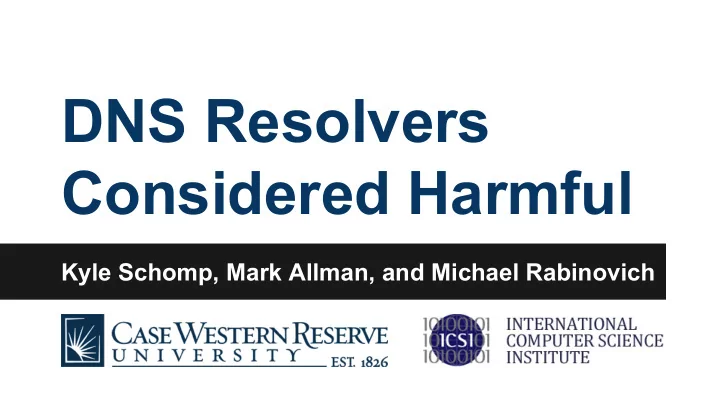

DNS Resolvers Considered Harmful Kyle Schomp, Mark Allman, and Michael Rabinovich
2 DNS resolvers abstract complexity and offer the possibility of improved performance and better scalability . Why are they harmful?
3 Resolvers Are Vulnerable to Cache Injection ● Kaminsky vulnerability discovered in 2008, 16% of resolvers vulnerable to Kaminsky attack in 2012 [1] ● Preplay attack discovered in 2014, millions of wifi routers acting as resolvers are vulnerable [1] ● Shulman attack discovered in 2013, 79% of resolvers vulnerable [2] [1] Schomp, Kyle, Tom Callahan, Michael Rabinovich, [2] Herzberg, Amir and Haya Shulman. “Fragmentation and Mark Allman. "Assessing DNS Vulnerability to Considered Poisonous, or: One-domain-to-rule-them- Record Injection." PAM (2014). all.org.” CNS (2013).
4 Resolvers Should Not Be Trusted ● Resolvers rewrite responses for non-existent domains, effects 24% of clients [1] ● Others intentionally participate in hijacking domains (e.g., Paxfire in 2011 [3] ) Many countries use resolvers to enable censorship [4] ● ● ...yet we give them access to sensitive user information [3] Weaver, Nicholas, Christian Kreibich, and Vern [4] Verkamp, John-Paul, and Minaxi Gupta. "Inferring Paxson. "Redirecting DNS for ads and profit." FOCI mechanics of web censorship around the world." 2nd (2011). FOCI (2012).
5 Resolvers Obscure Clients ● Client-resolver location mismatch, 7.5-15% of clients suffer reduced performance due to wrong CDN edge server [5] ● Resolvers hide client population reducing the effectiveness of DNS-based load balancing [5] Huang, Cheng, Ivan Batanov, and Jin Li. "A practical solution to the client-LDNS mismatch problem." SIGCOMM (2012).
6 Resolvers Used In Amplification Attacks 24 million open resolvers on the Internet today [6] ● DNS amplification attacks are massive [7] and growing in ● popularity [8] [6] http://openresolverproject.org/ [7] http://www.zdnet.com/the-largest-ddos-attack-didnt- [8] NSFOCUS 2014 Mid-Year DDoS Threat Report. break-the-internet-but-it-did-try-7000013225/ http://en.nsfocus.com/2014/SecurityReport_0922/190. html
7 Existing Solutions Solutions to some of these issues, e.g., ○ Random transaction IDs and source ports mitigate guessing attacks such as Kaminsky ○ Closing open resolvers thwarts amplification attacks and preplay ○ EDNS-client-subnet (ECS) reveals more information about clients behind a resolver ○ DNSSEC provides data integrity and protects against all fraudulent records
8 Existing Solutions Aren’t Working ● Resolvers are still vulnerable to Kaminsky 6 years after its publication ● Millions of open resolvers on the Internet ● Current DNSSEC standard released 10 years ago, but deployment is still low ● Vulnerabilities still being discovered
9 Looking In Another Direction ● Many security issues that are not being addressed currently ● Much of the attack surface lies on the resolvers Why don’t we just get rid of resolvers?
10 Current Situation You (on your laptop) ? ADNS servers (e.g., a.root-servers.net, a.gtld-servers.net, ns1.google.com)
11 Client Resolution ADNS servers (e.g., a.root-servers.net, a.gtld-servers.net, ns1.google.com) You (on your laptop)
12 What do we gain? Reduces system complexity Removes the target of cache injection attacks Client resolution not vulnerable to same attacks Benefits CDN load balancing and server selection
13 What do we lose? Resolver caches provide performance to the clients ...and scalability to the system Resolvers anonymize clients
14 But how much scalability and performance do we lose? Measuring The Impact We use trace driven simulations to estimate client resolutions negative impact. ● Trace driven simulations to estimate client resolution’s negative impact ● The data ○ Network of approximately 100 residences ○ 2 recursive resolvers ○ 4 months of observations ○ Recursive resolutions of each domain name in the data
15 Effect on Performance DNS resolvers can reduce resolution time due to shared caching. Resolution times in trace vs. in simulated client resolution
16 Simulated Resolution Time Resolutions take a bit longer.
16 Simulated Resolution Time Resolutions take a bit longer.
16 Simulated Resolution Time Resolutions take a bit longer.
17 ...But there’s some slack DNS responses are not used immediately.
17 ...But there’s some slack DNS responses are not used immediately.
17 ...But there’s some slack DNS responses are not used immediately.
18 Delay On Connections Only a small % of connections are delayed at all! (more details in the paper)
18 Delay On Connections Only a small % of connections are delayed at all! (more details in the paper)
18 Delay On Connections Only a small % of connections are delayed at all! (more details in the paper)
19 Finding #1: Performance impact of client resolution is small
20 Effect on Scalability DNS resolvers reduce number of resolutions reaching authoritative servers Resolutions per authoritative domain in trace vs. in client resolution
21 Load on Auth. Domains 93% of authoritative domains will not see an increase in load ~but~ popular domains (e.g., com, google.com) will ○ use com as exemplar
22 com Domain Load ● Average load increases by 3.41 times! ● Peak load only increases by 1.14 times ● Which is more representative of impact on com domain? ○ Uncertain, let’s make both manageable
23 Increase Record Time-to-Live ● SLD records normally have 2 days TTLs ● Roughly 1.1% of those records change during a week ● What happens when the TTL is 1 week? Average Load 3.41 => 2.13 times trace load Peak Load 1.14 => 1.03 times trace load
24 Increase Questions Per Query ● Currently 1 question per DNS query ● Protocol can support multiple questions ● What happens when we ask 2 questions per query? Average Load 3.41 => 1.61 times trace load Peak Load 1.14 => 1.06 times trace load (reduces number of packets, not number of queries)
25 Increase TTL And Questions ● What happens when TTL is 1 week and we ask 2 questions per query? Average Load 3.41 => 1.33 times trace load Peak Load 1.14 => 1.06 times trace load
26 Finding #2: Scalability impact of client resolution is manageable
27 Final Thoughts ● Removing resolvers offers many advantages ● ...and small loses ○ Loss of anonymity in queries ○ Increase in authoritative domain load ● DNS prefetching has reduced reliance upon shared caches
? Thank you! email me at kgs7@case.edu
Recommend
More recommend